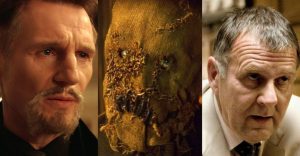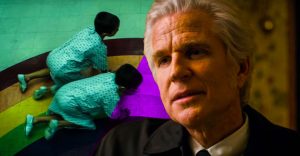5 Reasons That 28 Days Later Is The Greatest Zombie Movie Of All Time (& 5 Why It’s Night Of The Living Dead)

What makes a great zombie movie? Is it the scares, or brutal visual effects? Is it the sheer quantity of zombie hordes? Or is it the social commentary about humans being the real monsters of the story? It’s hard to pinpoint exactly why the zombie movie has had so much staying power since its inception.
Every list of the greatest zombie films inevitably includes two entries, Danny Boyle’s 28 Days Later and George Romero’s Night Of The Living Dead. These two films exist on opposite ends of the zombie spectrum, both in subject matter and era. But which one takes the crown for the greatest zombie movie of all time?
10 28 DAYS LATER: It Re-Energized The Genre

It’s safe to say that 28 Days Later is largely responsible for the zombie fever of the past decade. It is the first in the horde of media trying to recapture the success of the genre. It’s no wonder why 28 Days Later has had such a big influence, as it received both financial and critical success.
The most notable bit of zombie media that spiked its popularity near the start of the 2000s. By the end of the decade, fans of the genre would be treated to a TV drama version of The Walking Dead. Rick Grimes’ origins are eerily similar to Jim’s, both waking up from a coma after the collapse of civilization. It became clear audiences couldn’t get enough.
9 NIGHT OF THE LIVING DEAD: It Established The Tropes

Although Night Of The Living Dead isn’t the first zombie movie (that crown goes to 1932’s White Zombie), but it is the first instance of the modern zombie tropes that horror fans have learned to love. Previous incarnations of zombies were essentially hypnotized corpses, stuck between life and death, and forced to be slaves. This is keeping in tune with real occult beliefs (especially Voodoo) about zombies.
Night Of The Living Dead established the now well-known zombie facts. Here, zombies are corpses risen from the grave, their condition is passed on through bites, and they can be defeated by blows to the head or by fire. Night Of The Living Dead also established the trope of a group of survivors banding together and defending their base.
8 28 DAYS LATER: It Has Fast Zombies

If a survivor is careful and aware of their surroundings, they’ll have little trouble navigating the zombie wasteland. But how does one handle a zombie horde with the speed of Olympic sprinters? These sprinter zombies never tire, chasing their prey until exhaustion.
28 Days Later popularized the fast zombie and likewise influenced future incarnation of zombies, including those from Zombie Land and World War Z. This sort of zombie lends itself well to zombie films that lean towards action more so than horror, though they are nonetheless terrifying.
7 NIGHT OF THE LIVING DEAD: It Introduced The Classic Slow & Steady Zombies

To this day, many pieces of zombie media still rely on Night Of The Living Dead‘s slow and steady zombies. Their threat is not from their strength, but rather in their numbers. If a survivor isn’t careful, they could find themselves entirely overwhelmed by a wall of stumbling ghouls.
The Walking Dead is the best modern example of these slow-moving zombies, perfectly depicting their threat-level. Something about the slow zombie gives them a determined, calculating quality that emphasizes their undead nature. They’ll catch up to their target if it takes all day and night.
6 28 DAYS LATER: Innovative Cinematography

Danny Boyle isn’t just an early adopter of digital cameras in mainstream movies, he’s also responsible for storytelling innovations through the use of both digital and film. Audiences are unconsciously comfortable with the look of film cameras, due to their decades of use in the motion picture industry. Thus, moments of comfort in 28 Days Later are shot on film.
Digital cameras at the time still had a noticeably grimier aesthetic, as their image quality was not as clean as it is today. Boyle uses digital cameras in scenes of tension or shock, evoking a sense of discomfort and surreality from the post-apocalyptic setting. The result is an undeniable sense of dread that is hard to pin down for non-cinephiles in the audience.
5 NIGHT OF THE LIVING DEAD: The Brutally Raw Style

Night Of The Living Dead is surprisingly raw for a movie from 1968, no doubt due to its low budget. Romero leans into the rawness of the film’s look, often evoking at times a journalistic, documentary style.
Not only is the film full of gruesome close-ups of hungry ghouls, but it also has scenes shot like a news report, and even ends on a photo montage reminiscent of newspaper photography. All of these elements come together to evoke startling realness that is rare for a film of this era.
4 28 DAYS LATER: Its Realism

Some aspects of 28 Days Later may seem too real for current events. The origin of the zombies is based firmly in science, specifically, a virus that runs rampant through Britain. The film captures a very legitimate set of fear associated with living in a metropolitan area during a pandemic.
The virus in 28 Days Later isn’t just passed on through zombie bites, as it can also be transmitted through droplets of blood. Perhaps the most frightening moment in the entire film is watching someone rapidly transform after coming into contact with a single drop of blood.
3 NIGHT OF THE LIVING DEAD: The Ghoulish Mystery

The origin of the undead nightmare is entirely unclear in Night Of The Living Dead. Is it demonic possession? An alien invasion Throughout the film, officials on TV are shown to be scrambling for answers to the ongoing murders. Everyone is in the same place, fumbling to find safety.
The lack of answers only adds to the film’s sense of panic, because there is no rhyme or reason for the dead rising from their graves. People fear that which they can’t understand, and Night Of The Living Dead takes full advantage of that fear.
2 28 DAYS LATER: Its Massive Scale

The sheer scale of 28 Days Later is a big part of its horror. To see a once-bustling city completely empty hammers home the message that something has gone terribly wrong in the world. The view of an empty city is an impressive feat for any film to successfully pull off.
The barren streets of London from the opening moments of the film perfectly establish the world of this film without any words. Jim has the world to himself, but he is also frighteningly alone. Few other, if any, zombie films have ever pulled off a similar level of loneliness.
1 NIGHT OF THE LIVING DEAD: The Intimate Setting

Night Of The Living Dead is rooted in an otherwise normal smalltown and its inhabitants. The setting is as much a character as the rest of the cast. There’s a strong focus on the safe home, each room and each floor is made abundantly clear. The bulk of the film’s drama is also centered on how best to defend the setting from approaching zombies.
As a result of this narrow focus on the home, it’s easy for viewers to put themselves in the shoes of the characters. It encourages audience members to wonder how they might go about protecting the same setting. For some, protecting a house is much more of a relatable idea than roaming the desolate streets of London.
About The Author

















